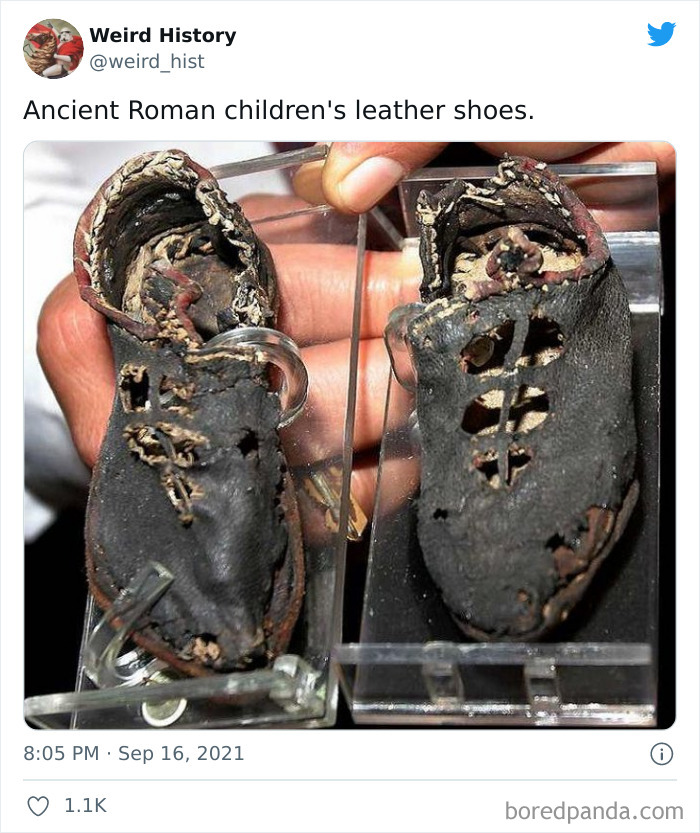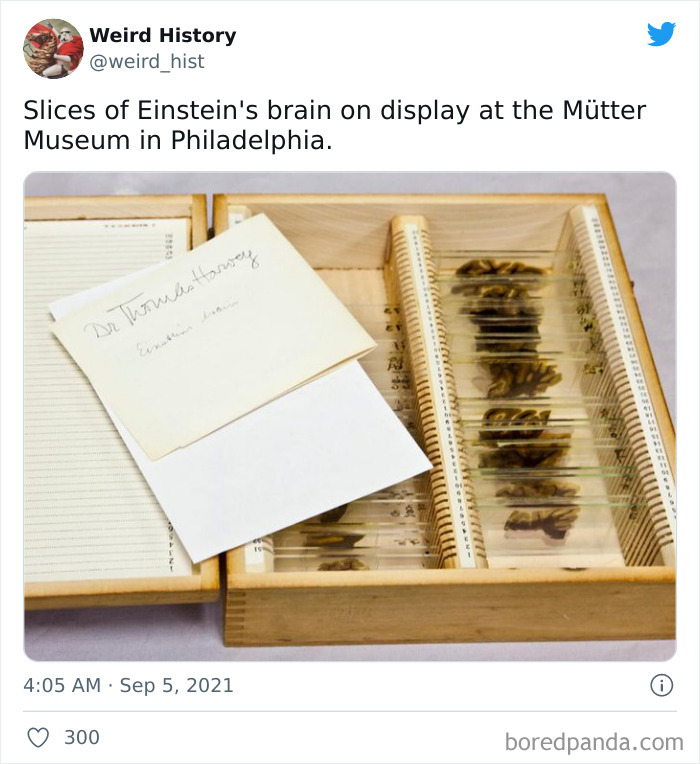
50 ‘Weird History’ Facts That History And Trivia Lovers Might Find Interesting (New Pics)
If it ain’t weird, interesting, and enlightening, it ain’t got any place on the Weird History Twitter page. Home to nearly 177k adoring fans, the Weird History project embodies the best aspects of education in the digital age: make it short, make it precise, and make it fun. Throw in some spot-on illustrations and boom! You’ve made yourself popular with fact-lovers all over the globe.
Created by Andrew Rader way back in September 2011, Weird History has been going strong ever since for more than a decade. There’s always a new fact, a new tidbit of trivia to hook your interest and keep you learning. Scroll down and enjoy the best post from Weird History. Don’t forget to upvote the facts you enjoyed learning the most and be sure to give the project a follow on your fave social media (it’s on almost all of them).
Meanwhile, I reached out to Lenore Skenazy, the president of Let Grow and the founder of the Free-Range Kids movement to learn about how parents can help encourage their kids to learn new things and develop fresh interests, whether historical or otherwise, without smothering them or putting undue pressure on them. You’ll find Bored Panda's interview about the importance of stepping back avoiding the urge to control everything as you scroll down.
Pssst, Pandas, over here! We know how much you enjoy learning new facts, especially all the cool history trivia that Weird History has to offer. After you’re done absorbing all the knowledge in this list, you should definitely check out Bored Panda’s previous features about ‘Weird History’ right over here: Part 1, Part 2, and Part 3.
More info: Twitter (Weird History) | Twitter (Andrew) | Instagram | Facebook | YouTube | Andrew-Rader.com
This post may include affiliate links.
Quite a few lost their lives doing this - deserve the highest respect!
MIT-credentialed scientist Andrew, the founder and curator of Weird History, is larger than life. Originally from Ottawa in Canada, he’s an author, game designer, podcast host, and SpaceX Mission Manager, living in Los Angeles in California. It’s amazing that so much awesomeness fits inside a single person.
Frankly, he’s an inspiration and walking, talking proof that you really can achieve your dreams if you’re dedicated, persistent, and focused. The fact that he has enough time in his day to curate the Weird History Twitter page, picking out the very best facts to share online, is just the icing on the cake.
The first Oscar was supposed to go to a dog. Rin Tin Tin received the most votes for best actor. The Academy held another voting round with humans only. They decided that giving a dog the first Oscar would give the wrong impression. They gave it to a future Nazi filmmaker instead.
There are self portraits by artists from the 16th century doing exactly this. Painting themselves while looking into a mirror. Albrecht Dürer did one of himself in the nude even.
Child independence expert and author Lenore explained to Bored Panda that it is vital that parents take a step back and don’t overwhelm their kids with pressure the moment they start developing new interests. Patience and room to grow are incredibly important at moments like this.
“When a child develops a new interest, it can be tempting to say, ‘You like playing with clay? Great! I’ll enroll you in a ceramics class, and I’ll take you to the museum so you can study the sculptures, and we’ll arrange for you to go to Clay Camp this summer and…” she said how some parents start thinking and behaving when their kids start to develop a new interest. Whether it’s history or science, art or football.
“Stop. Breathe. Take a step back,” Lenore said that parents need to learn to slow down for their children’s sake. Similarly, if your kids take a sudden interest in history, the last thing that parents should do is immediately bombard them with books upon books, and sign them up to an after-school history club. Be patient, take a step back, don't overwhelm your kids.
But he couldn't get any aspirin - because the parrots-etamol! Ok I'll see myself out
According to Lenore, there’s a need for parents to find the difference between encouragement and control. “It’s great to encourage a child’s interests, but that doesn’t mean taking over. In other words, if a child likes playing with clay—lovely. Try to keep some clay around. If it turns into a deeper interest and they want to take a class or whatever, you can look into these.”
However, the expert noted that when parents and teachers start controlling every aspect of the kids’ interests, well, there’s hardly any interest left after that. “By putting an adult in charge of the activity—‘Today in ceramics class, children, we will be making a dog’—a child might actually end up a little LESS interested because now it’s not their thing anymore,” she warned.
Lenore, the founder of Let Grow and the Free-Range Kids movement, shared with Bored Panda that there are different kinds of motivation: intrinsic and extrinsic. “Intrinsic motivation is when you want to do something. Extrinsic motivation is when someone ELSE wants you to do something.” It’s vital to allow children to develop their own intrinsic motivation without others constantly crowding in around them, throughout the day. When kids are left to their own devices, they can determine who they are through what they’re actually interested in.
“Kids have plenty of extrinsic motivation all day at school. Even in classes they like, someone else is telling them what to do and how to do it. So some free time when they’re allowed to do something just for the pleasure of it— not a grade, not a trophy— allows them to discover what they really enjoy and, in a way, who they truly are,” Lenore said.
“Our free Let Grow Independence Kit helps kids figure out some new things to try on their own, and helps adults let them!” she added.
When a brothel in Pompeii was uncovered, the archaeologists came across rather explicit images and graffiti. Some of the graffiti was: "Thrust slowly", "Euplia was here... with two thousand beautiful men" and list prices: "Euplia sucks for five asses" (which is a currency name).
A while back, I spoke about learning to separate facts from fiction with Joseph M. Pierre, a professor of psychiatry from the David Geffen School of Medicine at UCLA. He told Bored Panda that most conspiracy theories in recent history ”have been fairly inconsequential without any largescale behavioral ramifications.” Theories about what happened to JFK and Princess Diana, 9/11 and Flat Earth conspiracies haven’t affected the real world. With one exception—climate change conspiracies.
Pink was considered the "little red", red was associated with soldiers and war. Blue on the other hand is considered the colour of the Virgin Mary. Makes you wonder how and why these colours were swapped.
And the word pink comes from the roses. I was called "little or light red" originally but the roses that color have ruffled or "pinked" edges. (like in pinking shears) They became known as "pinked roses," then eventually "pinks," (they're still called that in some places) and then their color came to be used for that shade of red.
Load More Replies...To be fair, not that much colour photography took place in the 1800s
Load More Replies...Until the early 20th century, boys wore dresses until between the ages of 2 - 8. Even then, they wore shorts until they were 4 or 5 when they were switched to pants buttoned at the knee. The basic reason was practicality. Diapers/nappies were bulky and it was quicker to change/clean them. Babies grow so fast that dresses lasted longer. The dresses got shorter as the boys grew to keep the hems cleaner and unframyed. As fashion changed, little boys were put in shorts for the same reason, then moved to buttoned knee britches (same reason). Cloth was very expensive and it needed to be made to last as long as possible.
And men used to wear heels, wigs and makeup. Another reason why it drives me nuts when people today gripe about men wearing things they think should only be worn by women.
Until post WWII, little boys wore dresses until they were toddlers. My proof is my oldest brother, who was born in 1942. There are oodles of pictures of him, up to about the age of 3, where he’s in a dress. Not a negative thing, it was common practice.
It used to be because pink was a strong color and blue was considered a light delicate one.
Girl on the far left looks like she takes no sass but gives plenty! lol
My father, born in 1937, used to were a dress when he was still in diapers.
I have a photo of my much-older brother in a dress in 1948, with a bow in his hair. For years I thought it was a photo of me, as I am a girl.
Makes you wonder why we judge babies on the colours of their clothes. Or anyone else.
say it with me " gender roles and their stereotypes have and always will be a social construct":)
According to Britannica.com little kids all wore white up until the 20th century. "In 1918 the trade publication Earnshaw’s Infants’ Department claimed the 'generally accepted rule is pink for the boys, and blue for the girls. The reason is that pink, being a more decided and stronger color, is more suitable for the boy, while blue, which is more delicate and dainty, is prettier for the girl.' " Unfortunately they don't go into WHY the colours later flipped in the 40ies. (https://www.britannica.com/story/has-pink-always-been-a-girly-color)
I think pink became the "GiRlS' cOlOuR" after one of the World Wars. This was probably because pink became associated with military during that time, or something, and when they returned, girls and women started wearing pink as a sign of equality
I knew this (from simpsons: "I am also Scotty"), but have not seen a picture of Mr Nimoy in Spock costume smiling until today. Mind blown (edit: I love his smile!)
“Not all of the debate around that topic involves a conspiracy theory. In fact, the most conspiratorial claim about climate change may be that ‘big oil’ companies, like ‘big tobacco’ decades before, know that climate change is real and is caused by human CO2 production, but that they’re purposely claiming otherwise and putting out misinformation to the contrary that refutes what the vast majority of climate change scientists have stated in order to protect profits from the industry,” the professor told Bored Panda.
“Those of us who believe that conspiracy theory (remembering that some conspiracy theories are true!) argue that real-life physical actions—more so on the part of industry than individuals per se—are necessary now,” he said that the time to fight back against climate change is better sooner than later.
Every new invention or method of gaining independence is "bad for women" 🙄
“Determining if someone is lying isn’t easy and is complicated by the fact that we don’t really have clear agreement of what it means to ‘believe’ something, much less genuinely,” the professor said that it’s very difficult to establish whether someone truly believes a conspiracy theory that they tout or if they’re incredibly good at pretending.
So, Pandas, which Weird History facts got stuck in your heads? Were there any bits of trivia that you already knew? Are there any facts that you’d just looove to share with your friends? Share your thoughts (and any other cool history facts that you know!) in the comment section at the bottom of the article. We can’t wait to hear what you think!
I've never seen this many cats on a leash. let alone this many cats on a leash who weren't on their side dramatically protesting.
This guy was a genius! He also was a hoot! Apparently at a dinner a woman said if she was married to him she'd poison his tea. He responded If I was married to you I'd drink it!
"United States servicemen would draw the picture and the text 'Kilroy was here' on the walls and other places where they were stationed, encamped, or visited. An ad in Life magazine noted that WWII-era servicemen were fond of claiming that "whatever beach-head they stormed, they always found notices chalked up ahead of them, that 'Kilroy was here'" (Wikipedia) This is the same story my grandfather used to tell.
No longer accurate. Tree ring data measuring a cosmic ray blast recently pinned their arrival down to exactly 1,000 years ago, in 1021 CE.
I have to express some skepticism here... 1) What likely counts as the very first legitimate online transaction goes to Dan Kohn in August 1994, who creating a website called NetMarket, the Shopify video reports. On August 11, Kohn sold a CD of Sting’s "Ten Summoner’s Tales" to a friend in Philadelphia, writes Peter H. Lewis wrote for The New York Times. 2) However, this (cannabis) exchange doesn’t check all the boxes for e-commerce: it was illegal and money wasn’t transferred online. Instead, the event probably represents the first deal facilitated by the internet.
A lot of these unusual drops are symbolic. Maybe it is meant as a message to the enemy that you are tired of taking shít from them... I seem to remember In WW II, there was a huge fake airport built out of wood by the German military in the occupied Netherlands as a decoy. British airforce, having known this from the beginning, bombed it with a single wooden bomb dummy with the words "Wood for Wood" on the hull.
The working title for the project was "Pylone de 300 mètres de hauteur" - Pylon with a height of 300 meters :)
Yeah the whole garden gnome thing wasn't correct. Rich people a long time ago had Garden Hermits, basically an old person who dressed like a druid and lived in their garden. Garden Gnomes came from that because people couldn't afford to hire a Garden Hermit but they still wanted status, so Garden Gnomes became a thing so people could have their own garden hermits. I got sucked into a side quest on Google and wound up in Garden Druid land. It was an interesting adventure.
Do people still want garden hermits? I will gladly be one
Load More Replies...Yeah the whole garden gnome thing wasn't correct. Rich people a long time ago had Garden Hermits, basically an old person who dressed like a druid and lived in their garden. Garden Gnomes came from that because people couldn't afford to hire a Garden Hermit but they still wanted status, so Garden Gnomes became a thing so people could have their own garden hermits. I got sucked into a side quest on Google and wound up in Garden Druid land. It was an interesting adventure.
Do people still want garden hermits? I will gladly be one
Load More Replies...
 Dark Mode
Dark Mode 

 No fees, cancel anytime
No fees, cancel anytime 












































































































































